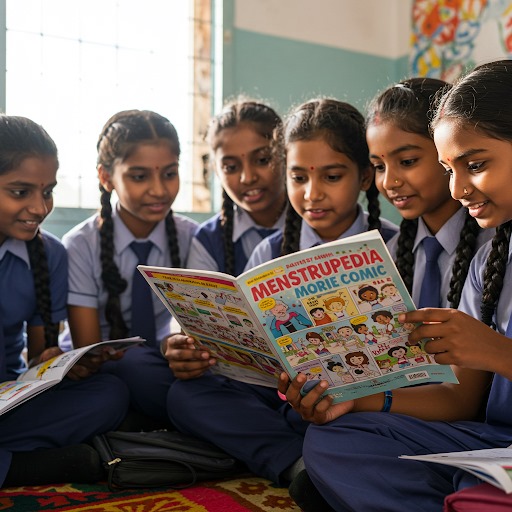Aditi Gupta
Aditi Gupta, founder of Menstrupedia, empowers 15 million girls globally through comics on menstruation, breaking taboos with culturally sensitive education used in 36,500+ schools across 23 countries. Dr. Debleena Bhattacharya, Associate editor, interviews her on about transforming girls lives through comic menstrupedia.

Q: What inspired you to create Menstrupedia? What specific gaps or needs did you identify?
The inspiration for Menstrupedia came from a very personal journey. Growing up in a small town like Garhwa, I experienced firsthand the lack of awareness and the deep-rooted stigma around menstruation. It wasn’t until a discussion with my partner, Tuhin, during our postgraduation studies that I realized how little even we, as educated individuals, knew about menstruation. That was an eye-opener.
When we started researching, we found that menstrual unawareness wasn’t just a rural issue—it existed in urban, educated families as well. Parents and teachers wanted to educate young girls about periods, but they lacked the right tools and felt uncomfortable discussing it due to societal taboos. We also noticed that while girls typically got their periods in classes six and seven, schools only introduced the topic in standard eight or nine, and even then, teachers often skipped it. This meant that young girls had nowhere to turn for accurate information.
That’s when we thought—what if we could create something that made learning about menstruation engaging and approachable? During my research, I collected stories of girls’ real experiences with periods, and I realized that storytelling could be a powerful way to break the silence. This led to the idea of a comic book that would educate girls in a fun and culturally sensitive way while also making it easier for parents and teachers to talk about menstruation. Our goal was to create an environment where periods were no longer a taboo subject, and Menstrupedia was our way of making that happen.
Q: What were the biggest challenges you faced in the initial stages of developing Menstrupedia, and how did you overcome them?
One of the biggest challenges we faced initially was raising funds to print the first thousand copies of our book. People did not believe that India was ready for a book on menstruation. To overcome this, we turned to crowdfunding, where people could pre-book the book before it was even printed. Our goal was to raise four lakhs, but we ended up raising 5.1 lakhs, which showed that there was indeed a demand for such a resource. This success helped us bring Menstrupedia to life and reach more people than we initially expected.

Q: Can you describe the process of creating the Menstrupedia comic book? What was the inspiration behind the comic book format?
Initially, we experimented with different formats, including creating a computer game. However, since we were not game designers, and a digital game requires electricity and internet for distribution, we realized it wouldn’t be the best solution for a problem as widespread as menstrual taboo.
That’s when we turned to books, specifically the comic format, as an inclusive and accessible medium. We had been reading about how graphic narratives are often used to discuss sensitive topics, and we felt that a comic book would be the perfect way to engage young girls while making the subject of menstruation easier to understand. This led to the creation of Menstrupedia, designed to be both informative and culturally sensitive.
Q: What impact has Menstrupedia created in enabling positive conversations around periods?
Menstrupedia has achieved significant impact in menstrual health education. To quantify that, we’ve seen our comic books integrated into the curriculum of 36,500 schools across India, directly reaching and educating 15 million girls about menstruation. Furthermore, we’ve expanded our reach globally. Our books are locally printed and published in 11 different countries, tailored to their respective languages, and we ship them from India to an additional 23 countries. This multi-pronged approach, combining curriculum integration with widespread availability, has allowed us to make a substantial contribution to menstrual hygiene awareness.
Q: How do you see Menstrupedia contributing to the broader conversation around menstrual health and gender equality in the years to come?

Menstrupedia is already contributing by normalizing conversations around menstruation. Our work has played a role in policy changes like menstrual leave policies and has helped shift how openly people talk about periods.
However, there is still a long way to go. Every year, 1.2 crore girls reach puberty, and our goal is to create a future where every single girl knows about menstruation at the right time. By continuing our efforts in education and awareness, Menstrupedia aims to ensure that menstrual health is no longer a taboo but an essential part of gender equality discussions.
Q: What advice would you give to other women entrepreneurs who want to create positive change in their communities through innovative solutions?
My key suggestions for entrepreneurs tackling social problems, particularly in India, would be these: First, embrace prototyping. There’s never been a better time to experiment and iterate. Build something tangible, even if it’s basic. Secondly, ensure your prototype works effectively for you. If you’ve addressed your own pain points, chances are, you’ve solved a problem for many others, and some will be willing to pay for it. Finally, and crucially, avoid creating ‘poor solutions for poor people’. It’s a common trap to offer cheap, quick fixes because you assume your target demographic can’t afford more. Instead, focus on creating quality solutions, and then explore alternative funding models or cross-subsidization, where other customer segments might support the social mission.”

